Faculty of Technology ENGT5115: Sustainable Development and Energy
VerifiedAdded on 2022/08/27
|11
|3093
|21
Essay
AI Summary
This essay investigates the crucial role of renewable energy in achieving sustainable development. It begins with an introduction to sustainable development (SD) and the importance of renewable energy sources such as solar, wind, biomass, and geothermal energy. The paper emphasizes the significance of the United Nations' Sustainable Development Goals (SDGs), particularly SDG-7, which focuses on affordable and clean energy. The essay delves into the definition of SD and the benefits of renewable energy, highlighting its positive impact on both developing and developed countries. It examines how renewable energy sources can meet the needs of the present without compromising future generations' ability to meet their own needs. The paper discusses the role of renewable energy in society, addressing global issues like climate change and resource scarcity. It also covers various sustainable energy solutions (SES) like solar, biomass, wind, hydro, marine, and geothermal energy, concluding that renewable energy is essential for a sustainable future.
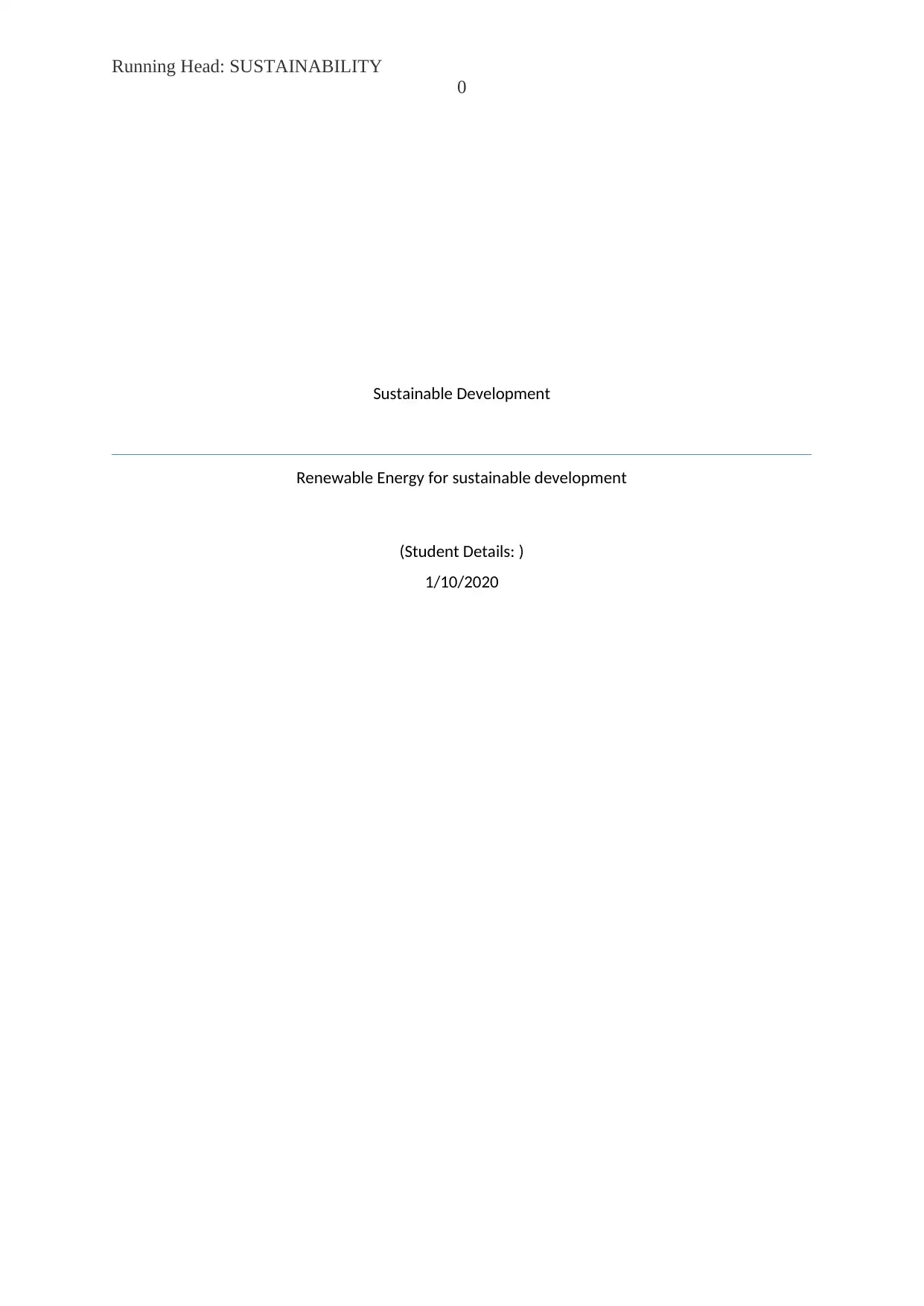
Running Head: SUSTAINABILITY
0
Sustainable Development
Renewable Energy for sustainable development
(Student Details: )
1/10/2020
0
Sustainable Development
Renewable Energy for sustainable development
(Student Details: )
1/10/2020
Paraphrase This Document
Need a fresh take? Get an instant paraphrase of this document with our AI Paraphraser
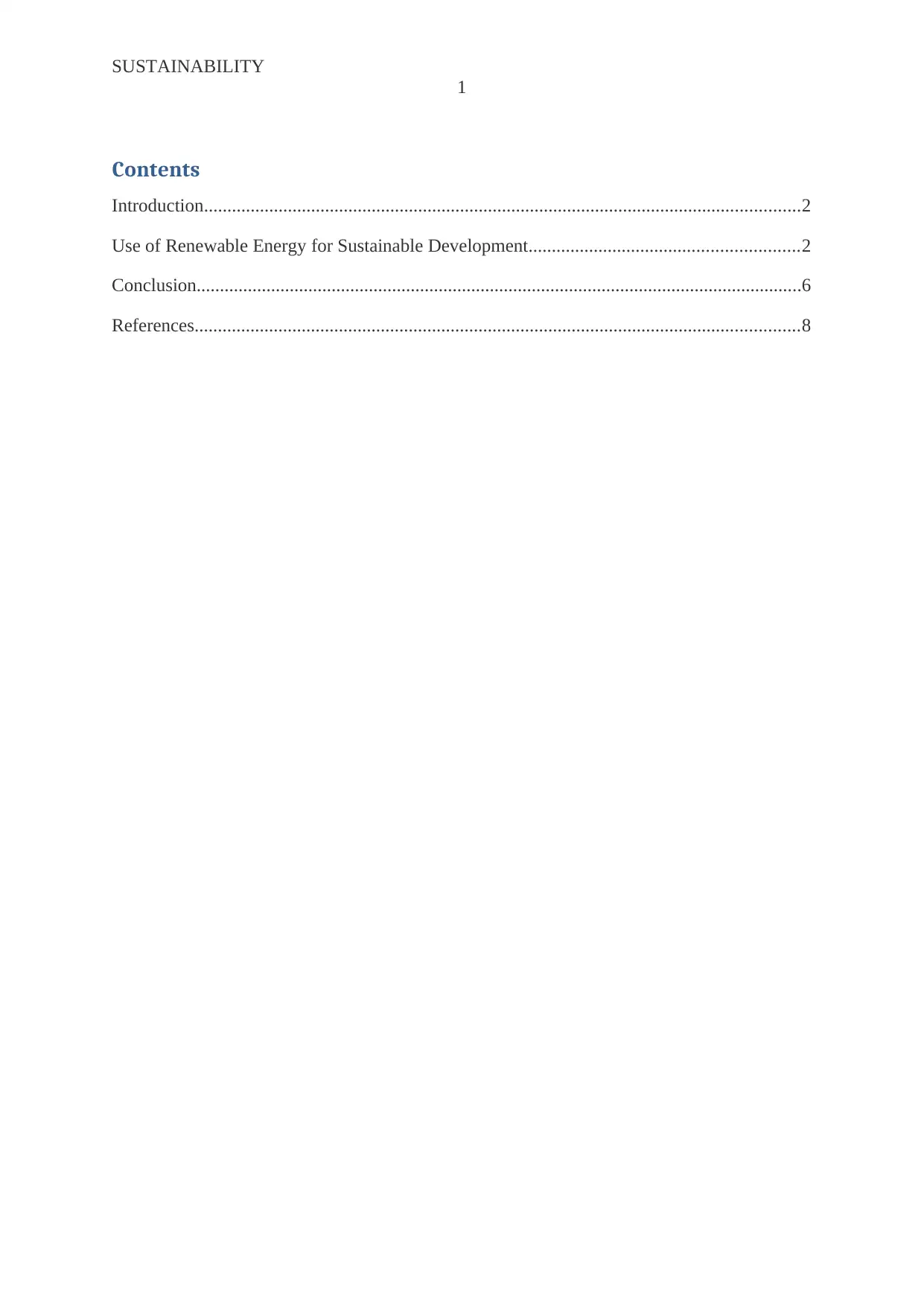
SUSTAINABILITY
1
Contents
Introduction................................................................................................................................2
Use of Renewable Energy for Sustainable Development..........................................................2
Conclusion..................................................................................................................................6
References..................................................................................................................................8
1
Contents
Introduction................................................................................................................................2
Use of Renewable Energy for Sustainable Development..........................................................2
Conclusion..................................................................................................................................6
References..................................................................................................................................8
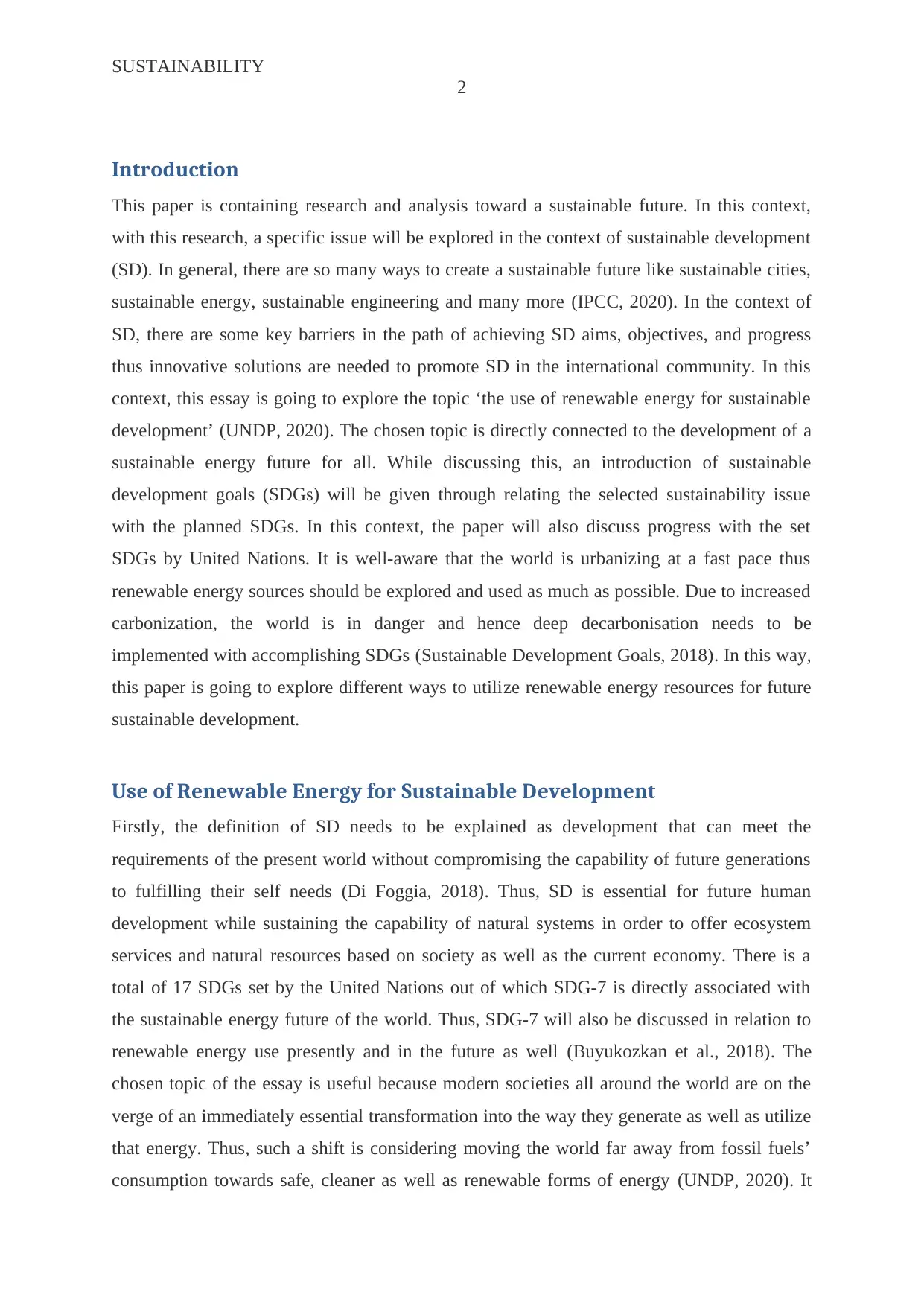
SUSTAINABILITY
2
Introduction
This paper is containing research and analysis toward a sustainable future. In this context,
with this research, a specific issue will be explored in the context of sustainable development
(SD). In general, there are so many ways to create a sustainable future like sustainable cities,
sustainable energy, sustainable engineering and many more (IPCC, 2020). In the context of
SD, there are some key barriers in the path of achieving SD aims, objectives, and progress
thus innovative solutions are needed to promote SD in the international community. In this
context, this essay is going to explore the topic ‘the use of renewable energy for sustainable
development’ (UNDP, 2020). The chosen topic is directly connected to the development of a
sustainable energy future for all. While discussing this, an introduction of sustainable
development goals (SDGs) will be given through relating the selected sustainability issue
with the planned SDGs. In this context, the paper will also discuss progress with the set
SDGs by United Nations. It is well-aware that the world is urbanizing at a fast pace thus
renewable energy sources should be explored and used as much as possible. Due to increased
carbonization, the world is in danger and hence deep decarbonisation needs to be
implemented with accomplishing SDGs (Sustainable Development Goals, 2018). In this way,
this paper is going to explore different ways to utilize renewable energy resources for future
sustainable development.
Use of Renewable Energy for Sustainable Development
Firstly, the definition of SD needs to be explained as development that can meet the
requirements of the present world without compromising the capability of future generations
to fulfilling their self needs (Di Foggia, 2018). Thus, SD is essential for future human
development while sustaining the capability of natural systems in order to offer ecosystem
services and natural resources based on society as well as the current economy. There is a
total of 17 SDGs set by the United Nations out of which SDG-7 is directly associated with
the sustainable energy future of the world. Thus, SDG-7 will also be discussed in relation to
renewable energy use presently and in the future as well (Buyukozkan et al., 2018). The
chosen topic of the essay is useful because modern societies all around the world are on the
verge of an immediately essential transformation into the way they generate as well as utilize
that energy. Thus, such a shift is considering moving the world far away from fossil fuels’
consumption towards safe, cleaner as well as renewable forms of energy (UNDP, 2020). It
2
Introduction
This paper is containing research and analysis toward a sustainable future. In this context,
with this research, a specific issue will be explored in the context of sustainable development
(SD). In general, there are so many ways to create a sustainable future like sustainable cities,
sustainable energy, sustainable engineering and many more (IPCC, 2020). In the context of
SD, there are some key barriers in the path of achieving SD aims, objectives, and progress
thus innovative solutions are needed to promote SD in the international community. In this
context, this essay is going to explore the topic ‘the use of renewable energy for sustainable
development’ (UNDP, 2020). The chosen topic is directly connected to the development of a
sustainable energy future for all. While discussing this, an introduction of sustainable
development goals (SDGs) will be given through relating the selected sustainability issue
with the planned SDGs. In this context, the paper will also discuss progress with the set
SDGs by United Nations. It is well-aware that the world is urbanizing at a fast pace thus
renewable energy sources should be explored and used as much as possible. Due to increased
carbonization, the world is in danger and hence deep decarbonisation needs to be
implemented with accomplishing SDGs (Sustainable Development Goals, 2018). In this way,
this paper is going to explore different ways to utilize renewable energy resources for future
sustainable development.
Use of Renewable Energy for Sustainable Development
Firstly, the definition of SD needs to be explained as development that can meet the
requirements of the present world without compromising the capability of future generations
to fulfilling their self needs (Di Foggia, 2018). Thus, SD is essential for future human
development while sustaining the capability of natural systems in order to offer ecosystem
services and natural resources based on society as well as the current economy. There is a
total of 17 SDGs set by the United Nations out of which SDG-7 is directly associated with
the sustainable energy future of the world. Thus, SDG-7 will also be discussed in relation to
renewable energy use presently and in the future as well (Buyukozkan et al., 2018). The
chosen topic of the essay is useful because modern societies all around the world are on the
verge of an immediately essential transformation into the way they generate as well as utilize
that energy. Thus, such a shift is considering moving the world far away from fossil fuels’
consumption towards safe, cleaner as well as renewable forms of energy (UNDP, 2020). It
⊘ This is a preview!⊘
Do you want full access?
Subscribe today to unlock all pages.

Trusted by 1+ million students worldwide
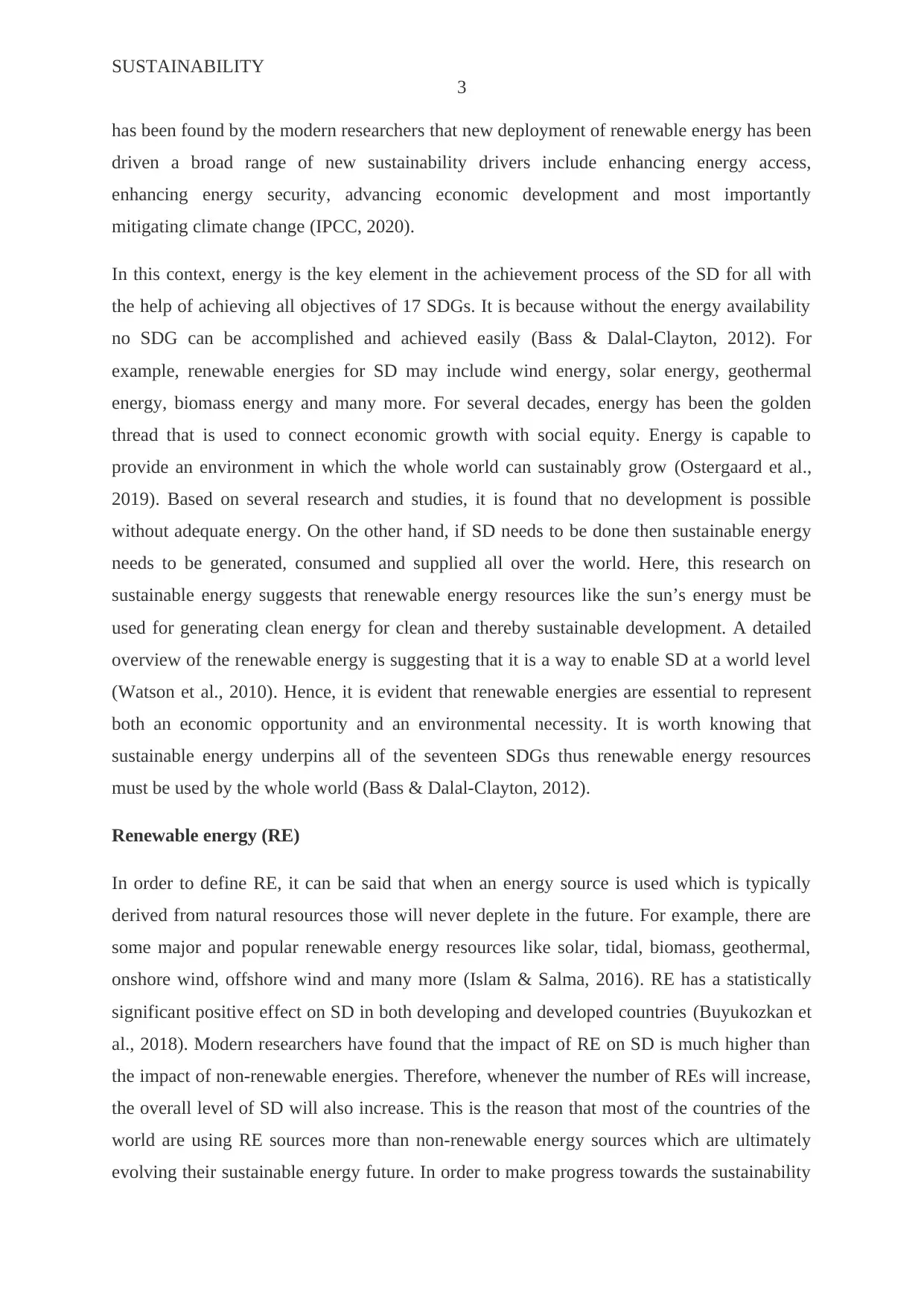
SUSTAINABILITY
3
has been found by the modern researchers that new deployment of renewable energy has been
driven a broad range of new sustainability drivers include enhancing energy access,
enhancing energy security, advancing economic development and most importantly
mitigating climate change (IPCC, 2020).
In this context, energy is the key element in the achievement process of the SD for all with
the help of achieving all objectives of 17 SDGs. It is because without the energy availability
no SDG can be accomplished and achieved easily (Bass & Dalal-Clayton, 2012). For
example, renewable energies for SD may include wind energy, solar energy, geothermal
energy, biomass energy and many more. For several decades, energy has been the golden
thread that is used to connect economic growth with social equity. Energy is capable to
provide an environment in which the whole world can sustainably grow (Ostergaard et al.,
2019). Based on several research and studies, it is found that no development is possible
without adequate energy. On the other hand, if SD needs to be done then sustainable energy
needs to be generated, consumed and supplied all over the world. Here, this research on
sustainable energy suggests that renewable energy resources like the sun’s energy must be
used for generating clean energy for clean and thereby sustainable development. A detailed
overview of the renewable energy is suggesting that it is a way to enable SD at a world level
(Watson et al., 2010). Hence, it is evident that renewable energies are essential to represent
both an economic opportunity and an environmental necessity. It is worth knowing that
sustainable energy underpins all of the seventeen SDGs thus renewable energy resources
must be used by the whole world (Bass & Dalal-Clayton, 2012).
Renewable energy (RE)
In order to define RE, it can be said that when an energy source is used which is typically
derived from natural resources those will never deplete in the future. For example, there are
some major and popular renewable energy resources like solar, tidal, biomass, geothermal,
onshore wind, offshore wind and many more (Islam & Salma, 2016). RE has a statistically
significant positive effect on SD in both developing and developed countries (Buyukozkan et
al., 2018). Modern researchers have found that the impact of RE on SD is much higher than
the impact of non-renewable energies. Therefore, whenever the number of REs will increase,
the overall level of SD will also increase. This is the reason that most of the countries of the
world are using RE sources more than non-renewable energy sources which are ultimately
evolving their sustainable energy future. In order to make progress towards the sustainability
3
has been found by the modern researchers that new deployment of renewable energy has been
driven a broad range of new sustainability drivers include enhancing energy access,
enhancing energy security, advancing economic development and most importantly
mitigating climate change (IPCC, 2020).
In this context, energy is the key element in the achievement process of the SD for all with
the help of achieving all objectives of 17 SDGs. It is because without the energy availability
no SDG can be accomplished and achieved easily (Bass & Dalal-Clayton, 2012). For
example, renewable energies for SD may include wind energy, solar energy, geothermal
energy, biomass energy and many more. For several decades, energy has been the golden
thread that is used to connect economic growth with social equity. Energy is capable to
provide an environment in which the whole world can sustainably grow (Ostergaard et al.,
2019). Based on several research and studies, it is found that no development is possible
without adequate energy. On the other hand, if SD needs to be done then sustainable energy
needs to be generated, consumed and supplied all over the world. Here, this research on
sustainable energy suggests that renewable energy resources like the sun’s energy must be
used for generating clean energy for clean and thereby sustainable development. A detailed
overview of the renewable energy is suggesting that it is a way to enable SD at a world level
(Watson et al., 2010). Hence, it is evident that renewable energies are essential to represent
both an economic opportunity and an environmental necessity. It is worth knowing that
sustainable energy underpins all of the seventeen SDGs thus renewable energy resources
must be used by the whole world (Bass & Dalal-Clayton, 2012).
Renewable energy (RE)
In order to define RE, it can be said that when an energy source is used which is typically
derived from natural resources those will never deplete in the future. For example, there are
some major and popular renewable energy resources like solar, tidal, biomass, geothermal,
onshore wind, offshore wind and many more (Islam & Salma, 2016). RE has a statistically
significant positive effect on SD in both developing and developed countries (Buyukozkan et
al., 2018). Modern researchers have found that the impact of RE on SD is much higher than
the impact of non-renewable energies. Therefore, whenever the number of REs will increase,
the overall level of SD will also increase. This is the reason that most of the countries of the
world are using RE sources more than non-renewable energy sources which are ultimately
evolving their sustainable energy future. In order to make progress towards the sustainability
Paraphrase This Document
Need a fresh take? Get an instant paraphrase of this document with our AI Paraphraser
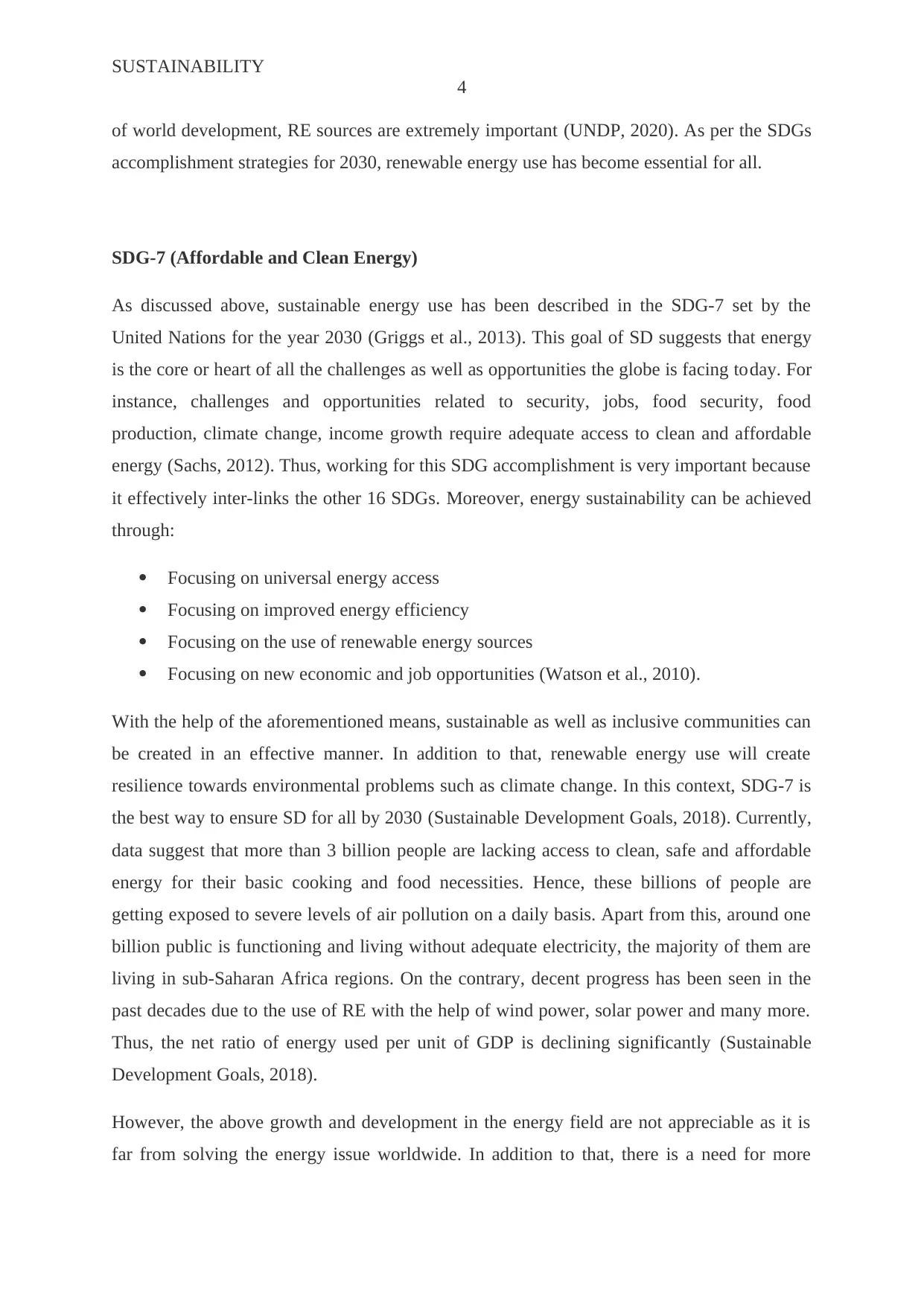
SUSTAINABILITY
4
of world development, RE sources are extremely important (UNDP, 2020). As per the SDGs
accomplishment strategies for 2030, renewable energy use has become essential for all.
SDG-7 (Affordable and Clean Energy)
As discussed above, sustainable energy use has been described in the SDG-7 set by the
United Nations for the year 2030 (Griggs et al., 2013). This goal of SD suggests that energy
is the core or heart of all the challenges as well as opportunities the globe is facing today. For
instance, challenges and opportunities related to security, jobs, food security, food
production, climate change, income growth require adequate access to clean and affordable
energy (Sachs, 2012). Thus, working for this SDG accomplishment is very important because
it effectively inter-links the other 16 SDGs. Moreover, energy sustainability can be achieved
through:
Focusing on universal energy access
Focusing on improved energy efficiency
Focusing on the use of renewable energy sources
Focusing on new economic and job opportunities (Watson et al., 2010).
With the help of the aforementioned means, sustainable as well as inclusive communities can
be created in an effective manner. In addition to that, renewable energy use will create
resilience towards environmental problems such as climate change. In this context, SDG-7 is
the best way to ensure SD for all by 2030 (Sustainable Development Goals, 2018). Currently,
data suggest that more than 3 billion people are lacking access to clean, safe and affordable
energy for their basic cooking and food necessities. Hence, these billions of people are
getting exposed to severe levels of air pollution on a daily basis. Apart from this, around one
billion public is functioning and living without adequate electricity, the majority of them are
living in sub-Saharan Africa regions. On the contrary, decent progress has been seen in the
past decades due to the use of RE with the help of wind power, solar power and many more.
Thus, the net ratio of energy used per unit of GDP is declining significantly (Sustainable
Development Goals, 2018).
However, the above growth and development in the energy field are not appreciable as it is
far from solving the energy issue worldwide. In addition to that, there is a need for more
4
of world development, RE sources are extremely important (UNDP, 2020). As per the SDGs
accomplishment strategies for 2030, renewable energy use has become essential for all.
SDG-7 (Affordable and Clean Energy)
As discussed above, sustainable energy use has been described in the SDG-7 set by the
United Nations for the year 2030 (Griggs et al., 2013). This goal of SD suggests that energy
is the core or heart of all the challenges as well as opportunities the globe is facing today. For
instance, challenges and opportunities related to security, jobs, food security, food
production, climate change, income growth require adequate access to clean and affordable
energy (Sachs, 2012). Thus, working for this SDG accomplishment is very important because
it effectively inter-links the other 16 SDGs. Moreover, energy sustainability can be achieved
through:
Focusing on universal energy access
Focusing on improved energy efficiency
Focusing on the use of renewable energy sources
Focusing on new economic and job opportunities (Watson et al., 2010).
With the help of the aforementioned means, sustainable as well as inclusive communities can
be created in an effective manner. In addition to that, renewable energy use will create
resilience towards environmental problems such as climate change. In this context, SDG-7 is
the best way to ensure SD for all by 2030 (Sustainable Development Goals, 2018). Currently,
data suggest that more than 3 billion people are lacking access to clean, safe and affordable
energy for their basic cooking and food necessities. Hence, these billions of people are
getting exposed to severe levels of air pollution on a daily basis. Apart from this, around one
billion public is functioning and living without adequate electricity, the majority of them are
living in sub-Saharan Africa regions. On the contrary, decent progress has been seen in the
past decades due to the use of RE with the help of wind power, solar power and many more.
Thus, the net ratio of energy used per unit of GDP is declining significantly (Sustainable
Development Goals, 2018).
However, the above growth and development in the energy field are not appreciable as it is
far from solving the energy issue worldwide. In addition to that, there is a need for more
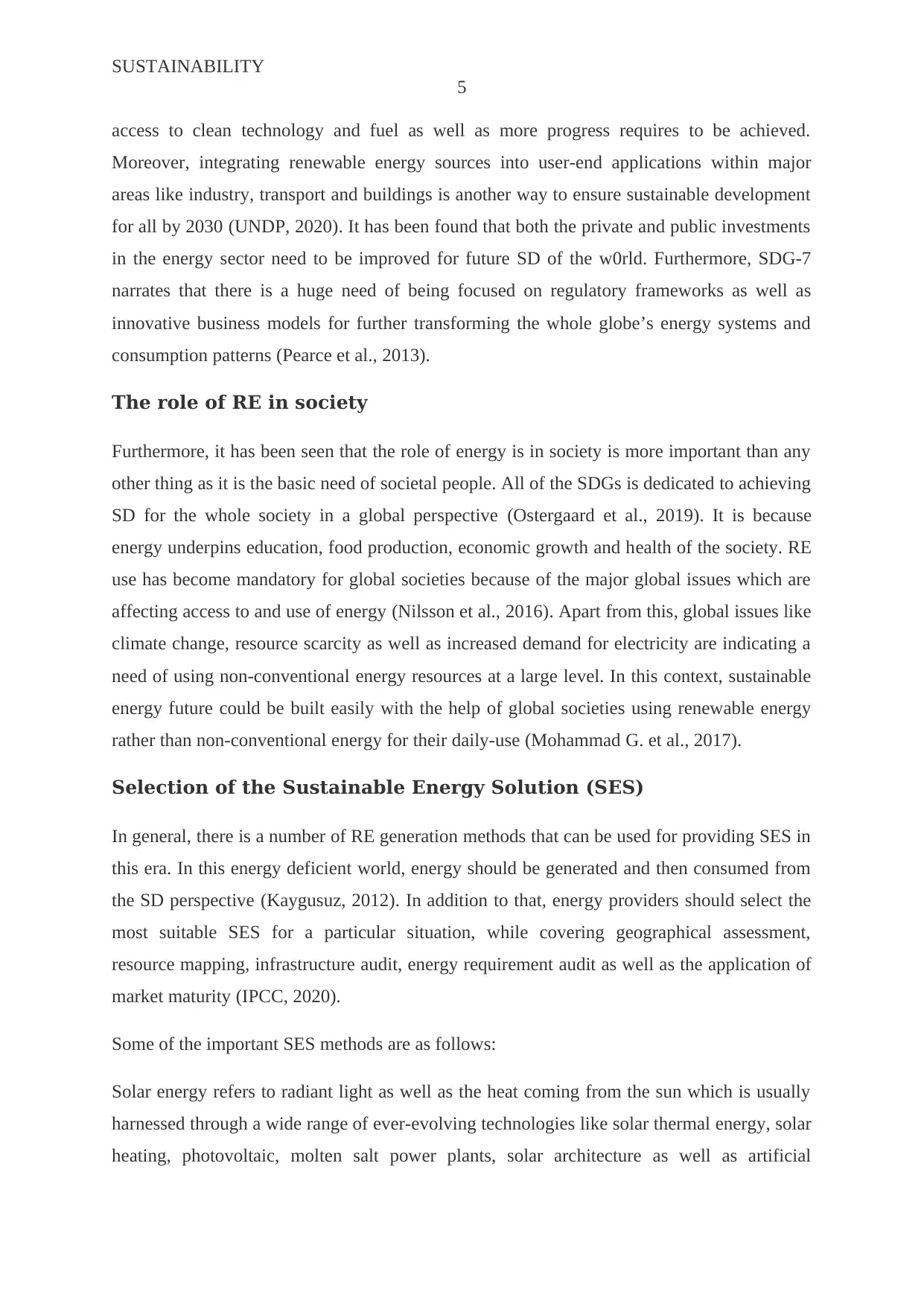
SUSTAINABILITY
5
access to clean technology and fuel as well as more progress requires to be achieved.
Moreover, integrating renewable energy sources into user-end applications within major
areas like industry, transport and buildings is another way to ensure sustainable development
for all by 2030 (UNDP, 2020). It has been found that both the private and public investments
in the energy sector need to be improved for future SD of the w0rld. Furthermore, SDG-7
narrates that there is a huge need of being focused on regulatory frameworks as well as
innovative business models for further transforming the whole globe’s energy systems and
consumption patterns (Pearce et al., 2013).
The role of RE in society
Furthermore, it has been seen that the role of energy is in society is more important than any
other thing as it is the basic need of societal people. All of the SDGs is dedicated to achieving
SD for the whole society in a global perspective (Ostergaard et al., 2019). It is because
energy underpins education, food production, economic growth and health of the society. RE
use has become mandatory for global societies because of the major global issues which are
affecting access to and use of energy (Nilsson et al., 2016). Apart from this, global issues like
climate change, resource scarcity as well as increased demand for electricity are indicating a
need of using non-conventional energy resources at a large level. In this context, sustainable
energy future could be built easily with the help of global societies using renewable energy
rather than non-conventional energy for their daily-use (Mohammad G. et al., 2017).
Selection of the Sustainable Energy Solution (SES)
In general, there is a number of RE generation methods that can be used for providing SES in
this era. In this energy deficient world, energy should be generated and then consumed from
the SD perspective (Kaygusuz, 2012). In addition to that, energy providers should select the
most suitable SES for a particular situation, while covering geographical assessment,
resource mapping, infrastructure audit, energy requirement audit as well as the application of
market maturity (IPCC, 2020).
Some of the important SES methods are as follows:
Solar energy refers to radiant light as well as the heat coming from the sun which is usually
harnessed through a wide range of ever-evolving technologies like solar thermal energy, solar
heating, photovoltaic, molten salt power plants, solar architecture as well as artificial
5
access to clean technology and fuel as well as more progress requires to be achieved.
Moreover, integrating renewable energy sources into user-end applications within major
areas like industry, transport and buildings is another way to ensure sustainable development
for all by 2030 (UNDP, 2020). It has been found that both the private and public investments
in the energy sector need to be improved for future SD of the w0rld. Furthermore, SDG-7
narrates that there is a huge need of being focused on regulatory frameworks as well as
innovative business models for further transforming the whole globe’s energy systems and
consumption patterns (Pearce et al., 2013).
The role of RE in society
Furthermore, it has been seen that the role of energy is in society is more important than any
other thing as it is the basic need of societal people. All of the SDGs is dedicated to achieving
SD for the whole society in a global perspective (Ostergaard et al., 2019). It is because
energy underpins education, food production, economic growth and health of the society. RE
use has become mandatory for global societies because of the major global issues which are
affecting access to and use of energy (Nilsson et al., 2016). Apart from this, global issues like
climate change, resource scarcity as well as increased demand for electricity are indicating a
need of using non-conventional energy resources at a large level. In this context, sustainable
energy future could be built easily with the help of global societies using renewable energy
rather than non-conventional energy for their daily-use (Mohammad G. et al., 2017).
Selection of the Sustainable Energy Solution (SES)
In general, there is a number of RE generation methods that can be used for providing SES in
this era. In this energy deficient world, energy should be generated and then consumed from
the SD perspective (Kaygusuz, 2012). In addition to that, energy providers should select the
most suitable SES for a particular situation, while covering geographical assessment,
resource mapping, infrastructure audit, energy requirement audit as well as the application of
market maturity (IPCC, 2020).
Some of the important SES methods are as follows:
Solar energy refers to radiant light as well as the heat coming from the sun which is usually
harnessed through a wide range of ever-evolving technologies like solar thermal energy, solar
heating, photovoltaic, molten salt power plants, solar architecture as well as artificial
⊘ This is a preview!⊘
Do you want full access?
Subscribe today to unlock all pages.

Trusted by 1+ million students worldwide
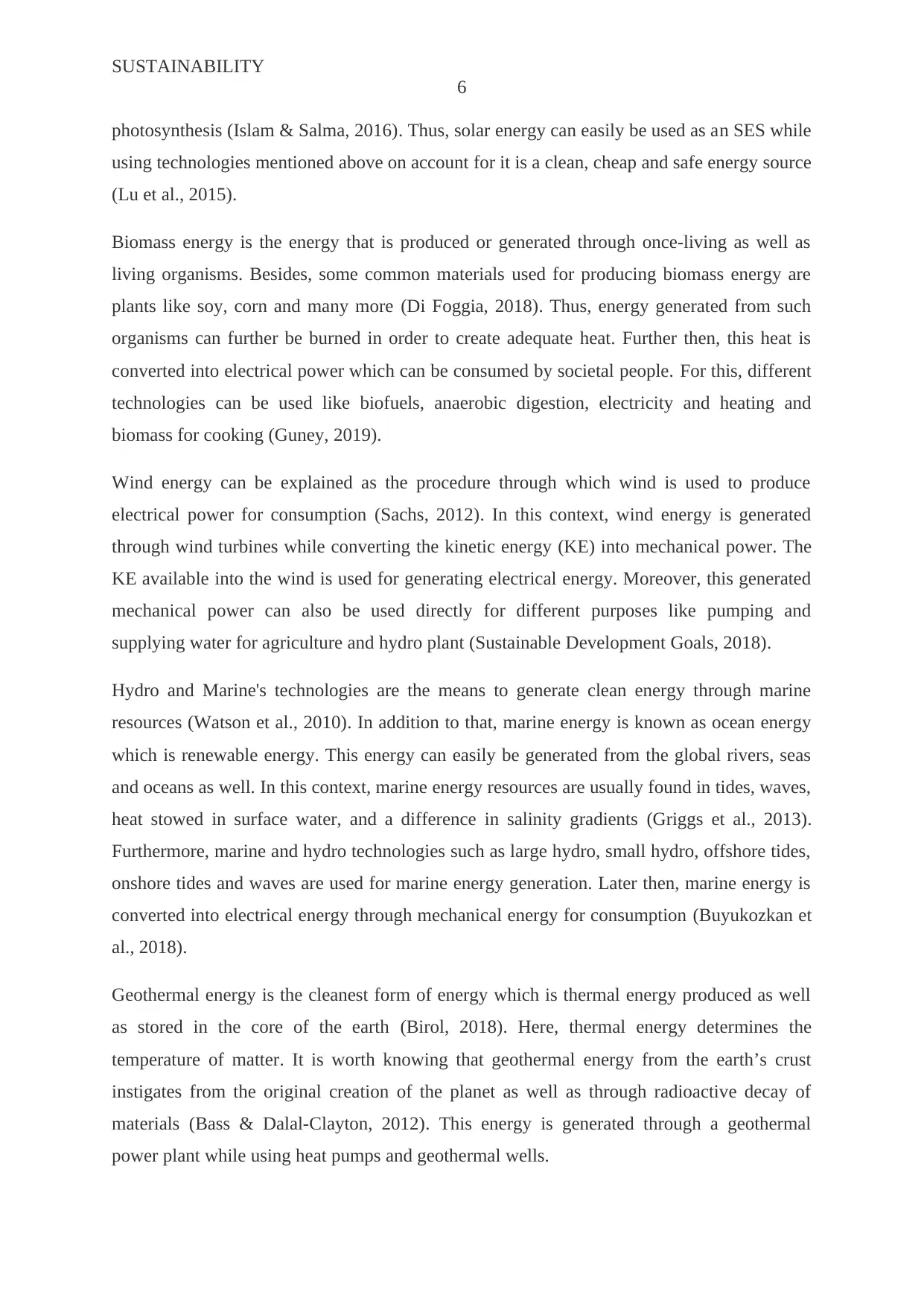
SUSTAINABILITY
6
photosynthesis (Islam & Salma, 2016). Thus, solar energy can easily be used as an SES while
using technologies mentioned above on account for it is a clean, cheap and safe energy source
(Lu et al., 2015).
Biomass energy is the energy that is produced or generated through once-living as well as
living organisms. Besides, some common materials used for producing biomass energy are
plants like soy, corn and many more (Di Foggia, 2018). Thus, energy generated from such
organisms can further be burned in order to create adequate heat. Further then, this heat is
converted into electrical power which can be consumed by societal people. For this, different
technologies can be used like biofuels, anaerobic digestion, electricity and heating and
biomass for cooking (Guney, 2019).
Wind energy can be explained as the procedure through which wind is used to produce
electrical power for consumption (Sachs, 2012). In this context, wind energy is generated
through wind turbines while converting the kinetic energy (KE) into mechanical power. The
KE available into the wind is used for generating electrical energy. Moreover, this generated
mechanical power can also be used directly for different purposes like pumping and
supplying water for agriculture and hydro plant (Sustainable Development Goals, 2018).
Hydro and Marine's technologies are the means to generate clean energy through marine
resources (Watson et al., 2010). In addition to that, marine energy is known as ocean energy
which is renewable energy. This energy can easily be generated from the global rivers, seas
and oceans as well. In this context, marine energy resources are usually found in tides, waves,
heat stowed in surface water, and a difference in salinity gradients (Griggs et al., 2013).
Furthermore, marine and hydro technologies such as large hydro, small hydro, offshore tides,
onshore tides and waves are used for marine energy generation. Later then, marine energy is
converted into electrical energy through mechanical energy for consumption (Buyukozkan et
al., 2018).
Geothermal energy is the cleanest form of energy which is thermal energy produced as well
as stored in the core of the earth (Birol, 2018). Here, thermal energy determines the
temperature of matter. It is worth knowing that geothermal energy from the earth’s crust
instigates from the original creation of the planet as well as through radioactive decay of
materials (Bass & Dalal-Clayton, 2012). This energy is generated through a geothermal
power plant while using heat pumps and geothermal wells.
6
photosynthesis (Islam & Salma, 2016). Thus, solar energy can easily be used as an SES while
using technologies mentioned above on account for it is a clean, cheap and safe energy source
(Lu et al., 2015).
Biomass energy is the energy that is produced or generated through once-living as well as
living organisms. Besides, some common materials used for producing biomass energy are
plants like soy, corn and many more (Di Foggia, 2018). Thus, energy generated from such
organisms can further be burned in order to create adequate heat. Further then, this heat is
converted into electrical power which can be consumed by societal people. For this, different
technologies can be used like biofuels, anaerobic digestion, electricity and heating and
biomass for cooking (Guney, 2019).
Wind energy can be explained as the procedure through which wind is used to produce
electrical power for consumption (Sachs, 2012). In this context, wind energy is generated
through wind turbines while converting the kinetic energy (KE) into mechanical power. The
KE available into the wind is used for generating electrical energy. Moreover, this generated
mechanical power can also be used directly for different purposes like pumping and
supplying water for agriculture and hydro plant (Sustainable Development Goals, 2018).
Hydro and Marine's technologies are the means to generate clean energy through marine
resources (Watson et al., 2010). In addition to that, marine energy is known as ocean energy
which is renewable energy. This energy can easily be generated from the global rivers, seas
and oceans as well. In this context, marine energy resources are usually found in tides, waves,
heat stowed in surface water, and a difference in salinity gradients (Griggs et al., 2013).
Furthermore, marine and hydro technologies such as large hydro, small hydro, offshore tides,
onshore tides and waves are used for marine energy generation. Later then, marine energy is
converted into electrical energy through mechanical energy for consumption (Buyukozkan et
al., 2018).
Geothermal energy is the cleanest form of energy which is thermal energy produced as well
as stored in the core of the earth (Birol, 2018). Here, thermal energy determines the
temperature of matter. It is worth knowing that geothermal energy from the earth’s crust
instigates from the original creation of the planet as well as through radioactive decay of
materials (Bass & Dalal-Clayton, 2012). This energy is generated through a geothermal
power plant while using heat pumps and geothermal wells.
Paraphrase This Document
Need a fresh take? Get an instant paraphrase of this document with our AI Paraphraser
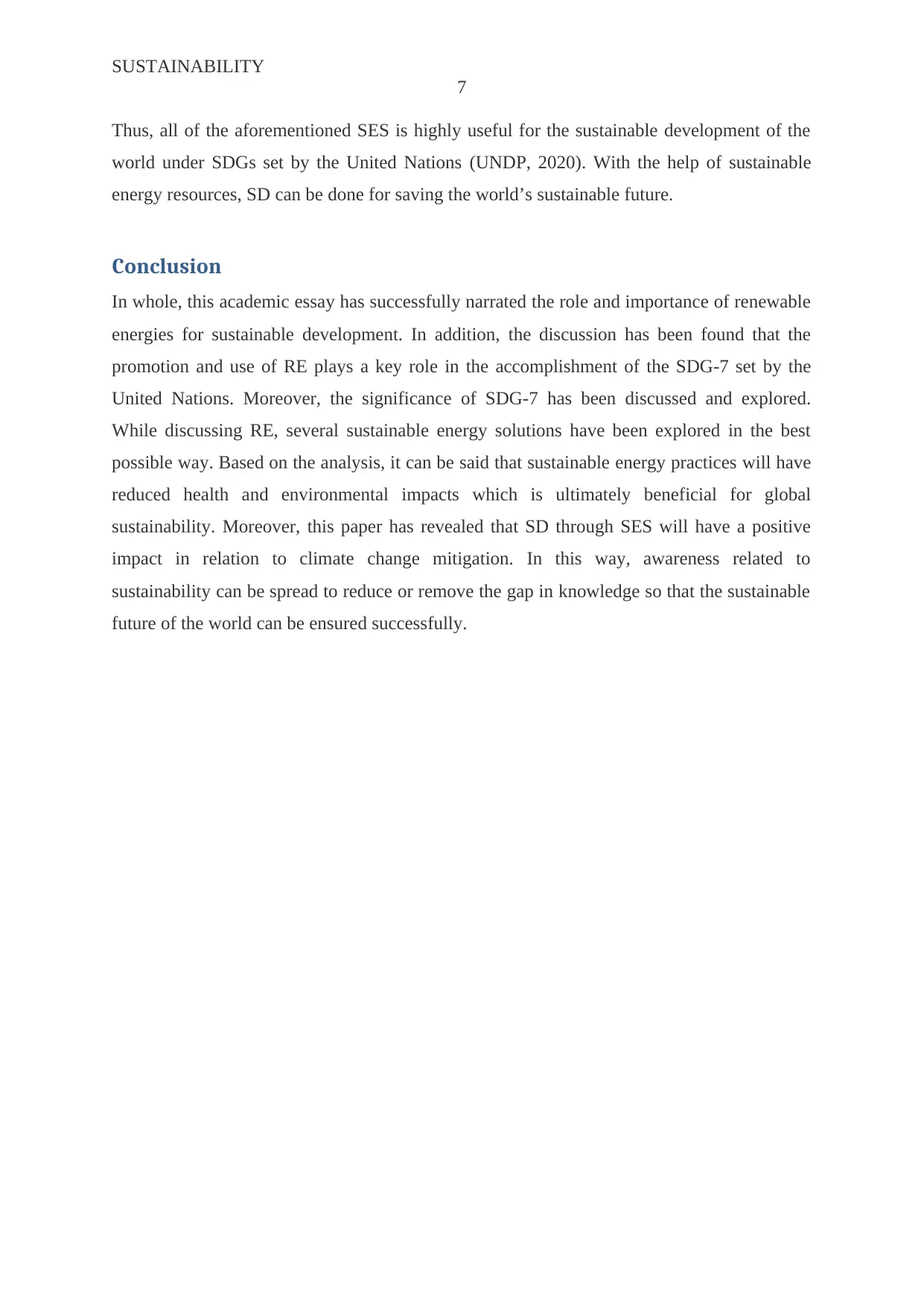
SUSTAINABILITY
7
Thus, all of the aforementioned SES is highly useful for the sustainable development of the
world under SDGs set by the United Nations (UNDP, 2020). With the help of sustainable
energy resources, SD can be done for saving the world’s sustainable future.
Conclusion
In whole, this academic essay has successfully narrated the role and importance of renewable
energies for sustainable development. In addition, the discussion has been found that the
promotion and use of RE plays a key role in the accomplishment of the SDG-7 set by the
United Nations. Moreover, the significance of SDG-7 has been discussed and explored.
While discussing RE, several sustainable energy solutions have been explored in the best
possible way. Based on the analysis, it can be said that sustainable energy practices will have
reduced health and environmental impacts which is ultimately beneficial for global
sustainability. Moreover, this paper has revealed that SD through SES will have a positive
impact in relation to climate change mitigation. In this way, awareness related to
sustainability can be spread to reduce or remove the gap in knowledge so that the sustainable
future of the world can be ensured successfully.
7
Thus, all of the aforementioned SES is highly useful for the sustainable development of the
world under SDGs set by the United Nations (UNDP, 2020). With the help of sustainable
energy resources, SD can be done for saving the world’s sustainable future.
Conclusion
In whole, this academic essay has successfully narrated the role and importance of renewable
energies for sustainable development. In addition, the discussion has been found that the
promotion and use of RE plays a key role in the accomplishment of the SDG-7 set by the
United Nations. Moreover, the significance of SDG-7 has been discussed and explored.
While discussing RE, several sustainable energy solutions have been explored in the best
possible way. Based on the analysis, it can be said that sustainable energy practices will have
reduced health and environmental impacts which is ultimately beneficial for global
sustainability. Moreover, this paper has revealed that SD through SES will have a positive
impact in relation to climate change mitigation. In this way, awareness related to
sustainability can be spread to reduce or remove the gap in knowledge so that the sustainable
future of the world can be ensured successfully.
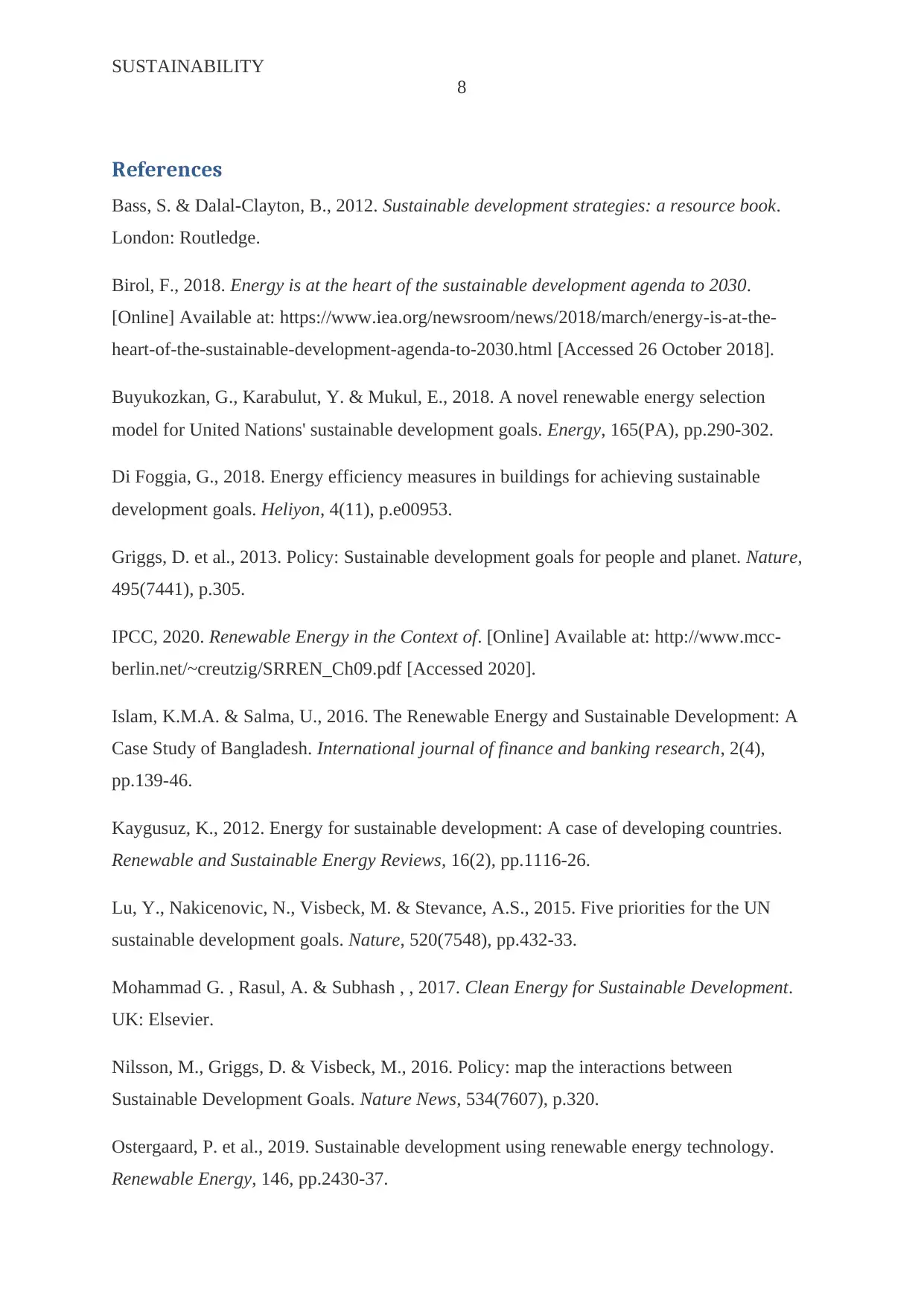
SUSTAINABILITY
8
References
Bass, S. & Dalal-Clayton, B., 2012. Sustainable development strategies: a resource book.
London: Routledge.
Birol, F., 2018. Energy is at the heart of the sustainable development agenda to 2030.
[Online] Available at: https://www.iea.org/newsroom/news/2018/march/energy-is-at-the-
heart-of-the-sustainable-development-agenda-to-2030.html [Accessed 26 October 2018].
Buyukozkan, G., Karabulut, Y. & Mukul, E., 2018. A novel renewable energy selection
model for United Nations' sustainable development goals. Energy, 165(PA), pp.290-302.
Di Foggia, G., 2018. Energy efficiency measures in buildings for achieving sustainable
development goals. Heliyon, 4(11), p.e00953.
Griggs, D. et al., 2013. Policy: Sustainable development goals for people and planet. Nature,
495(7441), p.305.
IPCC, 2020. Renewable Energy in the Context of. [Online] Available at: http://www.mcc-
berlin.net/~creutzig/SRREN_Ch09.pdf [Accessed 2020].
Islam, K.M.A. & Salma, U., 2016. The Renewable Energy and Sustainable Development: A
Case Study of Bangladesh. International journal of finance and banking research, 2(4),
pp.139-46.
Kaygusuz, K., 2012. Energy for sustainable development: A case of developing countries.
Renewable and Sustainable Energy Reviews, 16(2), pp.1116-26.
Lu, Y., Nakicenovic, N., Visbeck, M. & Stevance, A.S., 2015. Five priorities for the UN
sustainable development goals. Nature, 520(7548), pp.432-33.
Mohammad G. , Rasul, A. & Subhash , , 2017. Clean Energy for Sustainable Development.
UK: Elsevier.
Nilsson, M., Griggs, D. & Visbeck, M., 2016. Policy: map the interactions between
Sustainable Development Goals. Nature News, 534(7607), p.320.
Ostergaard, P. et al., 2019. Sustainable development using renewable energy technology.
Renewable Energy, 146, pp.2430-37.
8
References
Bass, S. & Dalal-Clayton, B., 2012. Sustainable development strategies: a resource book.
London: Routledge.
Birol, F., 2018. Energy is at the heart of the sustainable development agenda to 2030.
[Online] Available at: https://www.iea.org/newsroom/news/2018/march/energy-is-at-the-
heart-of-the-sustainable-development-agenda-to-2030.html [Accessed 26 October 2018].
Buyukozkan, G., Karabulut, Y. & Mukul, E., 2018. A novel renewable energy selection
model for United Nations' sustainable development goals. Energy, 165(PA), pp.290-302.
Di Foggia, G., 2018. Energy efficiency measures in buildings for achieving sustainable
development goals. Heliyon, 4(11), p.e00953.
Griggs, D. et al., 2013. Policy: Sustainable development goals for people and planet. Nature,
495(7441), p.305.
IPCC, 2020. Renewable Energy in the Context of. [Online] Available at: http://www.mcc-
berlin.net/~creutzig/SRREN_Ch09.pdf [Accessed 2020].
Islam, K.M.A. & Salma, U., 2016. The Renewable Energy and Sustainable Development: A
Case Study of Bangladesh. International journal of finance and banking research, 2(4),
pp.139-46.
Kaygusuz, K., 2012. Energy for sustainable development: A case of developing countries.
Renewable and Sustainable Energy Reviews, 16(2), pp.1116-26.
Lu, Y., Nakicenovic, N., Visbeck, M. & Stevance, A.S., 2015. Five priorities for the UN
sustainable development goals. Nature, 520(7548), pp.432-33.
Mohammad G. , Rasul, A. & Subhash , , 2017. Clean Energy for Sustainable Development.
UK: Elsevier.
Nilsson, M., Griggs, D. & Visbeck, M., 2016. Policy: map the interactions between
Sustainable Development Goals. Nature News, 534(7607), p.320.
Ostergaard, P. et al., 2019. Sustainable development using renewable energy technology.
Renewable Energy, 146, pp.2430-37.
⊘ This is a preview!⊘
Do you want full access?
Subscribe today to unlock all pages.

Trusted by 1+ million students worldwide
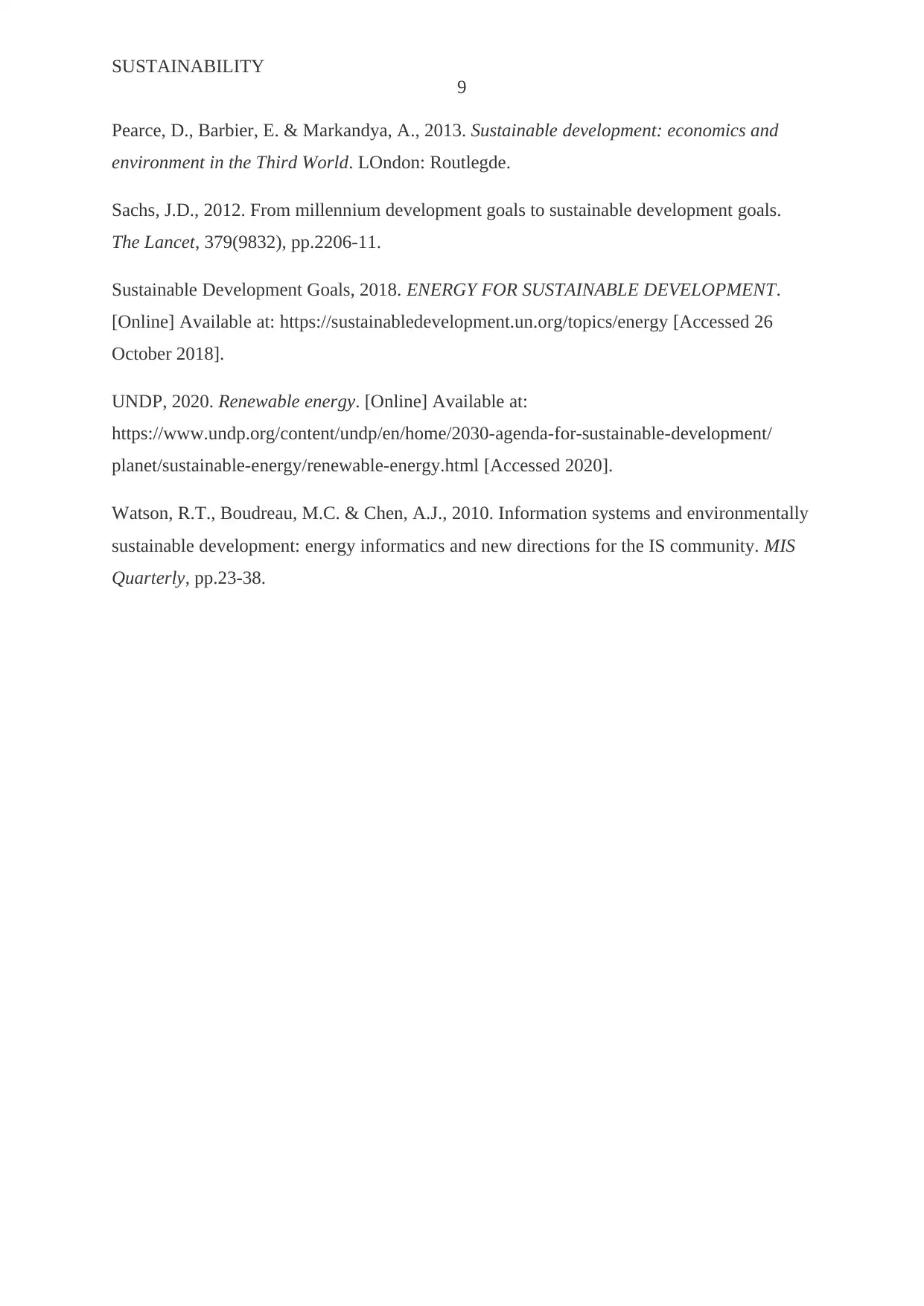
SUSTAINABILITY
9
Pearce, D., Barbier, E. & Markandya, A., 2013. Sustainable development: economics and
environment in the Third World. LOndon: Routlegde.
Sachs, J.D., 2012. From millennium development goals to sustainable development goals.
The Lancet, 379(9832), pp.2206-11.
Sustainable Development Goals, 2018. ENERGY FOR SUSTAINABLE DEVELOPMENT.
[Online] Available at: https://sustainabledevelopment.un.org/topics/energy [Accessed 26
October 2018].
UNDP, 2020. Renewable energy. [Online] Available at:
https://www.undp.org/content/undp/en/home/2030-agenda-for-sustainable-development/
planet/sustainable-energy/renewable-energy.html [Accessed 2020].
Watson, R.T., Boudreau, M.C. & Chen, A.J., 2010. Information systems and environmentally
sustainable development: energy informatics and new directions for the IS community. MIS
Quarterly, pp.23-38.
9
Pearce, D., Barbier, E. & Markandya, A., 2013. Sustainable development: economics and
environment in the Third World. LOndon: Routlegde.
Sachs, J.D., 2012. From millennium development goals to sustainable development goals.
The Lancet, 379(9832), pp.2206-11.
Sustainable Development Goals, 2018. ENERGY FOR SUSTAINABLE DEVELOPMENT.
[Online] Available at: https://sustainabledevelopment.un.org/topics/energy [Accessed 26
October 2018].
UNDP, 2020. Renewable energy. [Online] Available at:
https://www.undp.org/content/undp/en/home/2030-agenda-for-sustainable-development/
planet/sustainable-energy/renewable-energy.html [Accessed 2020].
Watson, R.T., Boudreau, M.C. & Chen, A.J., 2010. Information systems and environmentally
sustainable development: energy informatics and new directions for the IS community. MIS
Quarterly, pp.23-38.
Paraphrase This Document
Need a fresh take? Get an instant paraphrase of this document with our AI Paraphraser

SUSTAINABILITY
10
10
1 out of 11
Related Documents
Your All-in-One AI-Powered Toolkit for Academic Success.
+13062052269
info@desklib.com
Available 24*7 on WhatsApp / Email
![[object Object]](/_next/static/media/star-bottom.7253800d.svg)
Unlock your academic potential
Copyright © 2020–2025 A2Z Services. All Rights Reserved. Developed and managed by ZUCOL.




